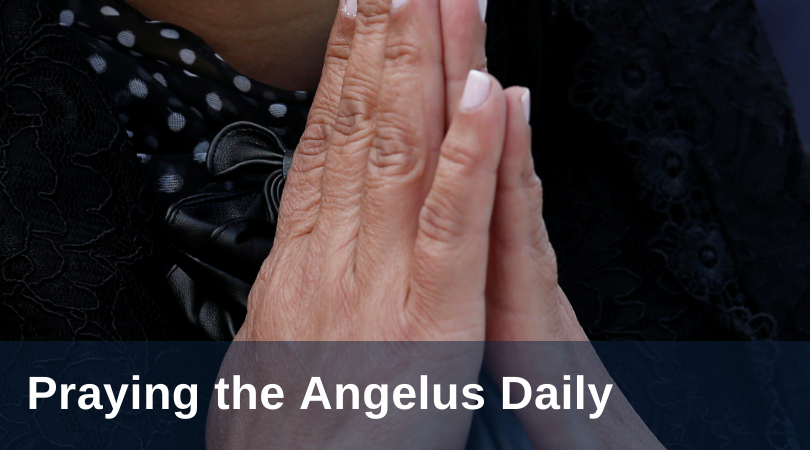
Every day at noon, the PA system at Christ the Redeemer School in Houston, TX, comes on with a ping! and an invitation rings out, “Please stand for the Angelus.” Throughout the entire building and campus (playground included), everyone from preschool through administration joins in praying the Angelus, recalling and praying the mystery of salvation that came through Mary’s “yes.”
What is the Angelus
The Angelus, a prayer with roots back to the 13th century, is a Marian devotion that is traditionally recited three times a day, usually at 6, noon, and 6. Each recitation includes three Hail Marys with antiphons and responses in between each. The genius of this devotion, especially in a place of catechesis like a Catholic school, is that it focuses on the Incarnation (an essential mystery of our faith) and that its practice mirrors its content.
A prayer that mirrors its content
Praying the Angelus interrupts whatever task you are in, just as the arrival of Christ in the Incarnation interrupts the world. At our school, the example set by teachers shows the students how to make space for God and prayer amidst daily life. Far from being a distraction, the welcome interruption of the Angelus teaches a life-long lesson: no activity is more important than prayer—not work, not study, not conversation, not even recess. The injunction to pray also reminds us of the meaning of our work, that we have been invited to a service of love by the God who first loved us.
Finally, every invitation to pray the Angelus is an opportunity to speak our own “yes” to God because every invitation to pray the Angelus is a moment of choice. Will I allow God to interrupt and enter this moment of my life? Or, will I favor the task at hand? For adults and children alike, the practice of saying “yes” in the Angelus is a two-fold practice of saying “yes” to God. First, by accepting the invitation to pray and, second, by repeating the words of Mary, “Be it done unto me according to thy word.” The hope and wisdom of the prayer is that day after day the “yes” to God becomes easier and the “yes” of Mary becomes our own.
How to pray the Angelus
To begin praying the Angelus, set a time to pray it once each day. You can associate it with a regular habit (like every day when you start your lunch break) or use an alarm on your phone, computer or other device to remind you. Once you establish the habit of praying the Angelus once daily, you’ll likely have it memorized and adding the two other times will be a natural next step.
The text of the Angelus is included below. As when praying the Creed at Mass, we traditionally bow in the Angelus for the line “and dwelt among us” to honor the moment of the Incarnation.
The Angelus
℣. The Angel of the LORD declared unto Mary,
℟. And she conceived of the Holy Spirit.
Hail Mary, full of grace; the LORD is with thee: blessed art thou amongst women, and blessed is the Fruit of thy womb, Jesus.* Holy Mary, Mother of God, pray for us sinners, now and at the hour of our death.
℣. Behold the handmaid of the LORD.
℟. Be it done unto me according to thy word.
Hail Mary, full of grace; the LORD is with thee: blessed art thou amongst women, and blessed is the Fruit of thy womb, Jesus.* Holy Mary, Mother of God, pray for us sinners, now and at the hour of our death.
℣. And the Word was made flesh.
℟. And dwelt among us. (Bowing slightly.)
Hail Mary, full of grace; the LORD is with thee: blessed art thou amongst women, and blessed is the Fruit of thy womb, Jesus.* Holy Mary, Mother of God, pray for us sinners, now and at the hour of our death.
℣. Pray for us, O Holy Mother of God.
℟. That we might be made worthy of the promises of Christ.
Let us pray,
Pour forth, we beseech Thee, O LORD, Thy grace into our hearts; that, we, to whom the Incarnation of Christ, Thy Son, was made known by the message of an angel, may by His Passion and Cross be brought to the glory of His Resurrection. Through the same Christ our Lord.
℟. Amen.

